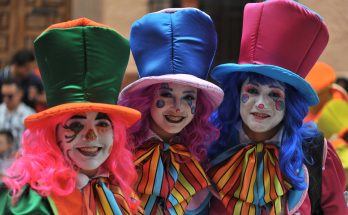By Francisco Peyret
Photo by Eugenio Ruiz
Honoring Don Leopoldo Estrada
Valle del Maíz is one of the oldest neighborhoods in San Miguel, an indigenous Chichimeca community, full of flavor and traditions, among which the Festival in honor of “La Santa Cruz de los espejos” stands out. Every May, the community organizes 13 days of celebration with diverse activities.
As Luis Felipe Rodríguez, the town chronicler or historian, points out, “All the works and activities are carried out with the consent and collaboration of all the neighbors. In this, they have always shown great unity, particularly in defense of their customs and traditions. Although several of the current neighbors do not belong to the original families and even some of them are foreigners, they have had to adapt, as it should be, to the customs of this iconic place where traditions are deeply rooted.” Among the activities of the festivity are the following: La velación del xúchil, combat of Indians against soldiers, the traditional yuntas, the main vigil of the Santa Cruz, alboradas, musical presentations, folkloric dances, mojiganga’s dance, foot races, cuadro de locos, parades, the long-awaited presentation of the Lions of the Sierra de Xichú and the end of the festivity is the colloquium, “The hidden treasure,” and finally, fireworks.
This year, the heart of the festivity will honor Doctor Leopoldo Estrada Buenrostro (Don Polo, as everybody called him), who passed away this last February 11. Don Polo was born on November 15, 1950, in Valle del Maíz, and was widely recognized for the elaboration of the mojigangas, an activity that led him to become a cultural promoter and bearer of the tradition.
Leopoldo Estrada’s cultural contribution began in September 1985, when he started his work in papier-mâché, cantoya balloons, castles, bulls, and mojigangas:
On her website, Celia Susana Ortiz Vázquez writes, “…the inspiration came to him when he ‘felt the patience and love with which Don Lupe Rodriguez caressed the paper with the paste, giving life and form to that inert material.’ Moved by the memory of his friend and master in San Miguel’s cartonería, whose work was recorded in some popular art books published abroad, he confided to us: ‘I marveled at his work in papier-mâché, cantoya balloons, castles, little bulls, mojigangas. She made an unimaginable chess of charros and chinas poblanas of five centimeters each piece.’”
I personally discovered Valle del Maíz some 25 years ago when my brother Miguel established his home and workshop to design and produce handcrafted furniture on the Libramiento al Caracol. I remember we would often go down in the afternoons, accompanied by my brother’s workers, to the heart of the neighborhood to play against the hardy kids who used to spend every afternoon on the court enjoying the good life. Every game became a real war. We, as good chilangos, always wanted to win, but we didn’t count on the unbreakable spirit of those young chichimecas. It all ended with a few beers in the middle of a very nice conversation between the two teams, which was joined by singular characters from the neighborhood.

A few months later, one fine day, the rumbling of the drums appeared, and every afternoon was filled with those ancient and distant sounds. Miguel then explained to me that the people of the community were preparing for the May festivities. That same year, I discovered that the Valle del Maíz Festival was a deep and serious thing.
A few years went by, and one fine day I arrived again to stay with my brother in the neighborhood, but this time I was accompanied by Anna, who was coming from Germany. At that time, my friend Wendy Vazquez who worked at FAI (Fundación de Apoyo Infantil), invited Anna to a volunteer program to produce mojigangas with a teacher from Valle del Maiz. It was through Anna’s stories that I learned about don Polo. She was amazed by his character and his stories. There, I guess, she learned something about cartoneria, but the best thing is that she discovered mezcal and the deep San Miguel.
Anna says that as a good German, she would ask don Polo a lot of questions, and he would sweetly answer her, “Yes, I will answer everything güerita, but first take a sip of your mezcal.”
At that same time, I briefly met don Polo in person. As fate would have it, he showed up at my office to ask for support for one of his projects. He was a quiet man, very gentle, and with a very particular way of telling his story. That day he explained to me that his community and its traditions were being overtaken by the new development of San Miguel. He said that becoming fashionable had its dangers, but it was necessary to adapt. And he was right. I remember that 25 years ago, Valle del Maíz was a neighborhood full of vacant lots; many streets were made of dirt, and the festivities were not promoted with the glamour of today. Fortunately, as don Polo foresaw, the people of the community have improved the festivities because they have been adapting.
About fifteen years later, I took Anna to the La Lejona health center to be treated because she had been bitten by a dog. It was there where Anna met don Polo again. I waited in the hallway for about two hours. Anna came out once again amazed with the character. There, she discovered that don Polo was a doctor who for many years was head of an emergency unit in Celaya and that, to de-stress, he enjoyed his passion for walking in the afternoons in Los Picachos. He was a lover of nature and reflection.
Don Polo was a man recognized by state and federal cultural institutions and took his work to the Cervantino International Festival and to many countries, but above all, he was a man recognized wholeheartedly by our entire community.
In February, El Charco del Ingenio, which for many years has highlighted the importance of the traditions of the original neighborhoods of San Miguel, issued a communiqué that sums up the figure of don Polo very well: “Dear Leopoldo Estrada, one of the founders and creators of the Botanical Garden, member of the Board of Directors of our association and a fighter always dedicated to the defense of the biocultural heritage of San Miguel de Allende and Mexico. In love with the oak forests of our mountains, he walked and loved them for years, seeking their preservation as natural areas. In addition to practicing as a doctor in rural communities from a very young age, his passion for popular culture led him to be a great imaginer, from whose hands came masks and mojigangas that gave life, movement, and dance to the huapangos and popular dances in San Miguel, in Real de Xichú, and beyond. But above all, Polo was a great companion and friend, a kind man who always radiated affection, humor, and confidence to those of us who surrounded him and had the good fortune to be his friends.




